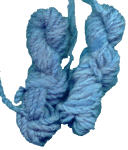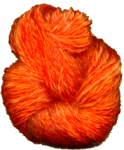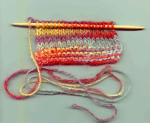Lollipops!:
![]() See the Lollies
See the Lollies
![]() Find a Lollie dealer
Find a Lollie dealer
![]() What makes a Lollie?
What makes a Lollie?
![]() Registered Lollies Worldwide
Registered Lollies Worldwide
![]() Dealer Inquiries Welcome!
Dealer Inquiries Welcome!
Educational:
![]() Drop Spin Instructions
Drop Spin Instructions
![]() Dyeing
Dyeing
![]() School Demos
School Demos
![]() Ask Stefie
Ask Stefie
Homespun
Spindles:
![]() What started all this?
What started all this?
![]() What's New?
What's New?
Web Stuff:
![]() E-mail us!
E-mail us!
![]() Favorite Links
Favorite Links
![]() Visit the Cyber Fiber Mall
Visit the Cyber Fiber Mall
![]() See our Awards
See our Awards
Dyeing Protein Fibers with Kool-Aid, Easter Egg Dyes and Food Colors
Please note - due to my scanner, the blues, which are a rich, deep turquoise, appear washed out.
A project to try yourself or share with the kids is dyeing fibers (yarn, loose fiber, roving) with non-toxic food grade dyes. Many people worry about the lightfastness of these dyes. I have had great results. The nice thing about these dyes is that they are environmentally friendly and easy to use. You can blend dyes or blend the dyed fibers to come up with new colors. The samples shown in the GIF were all done 3 or more years ago and have been sitting in a basket on a table waiting for inspiration to strike ever since. (Inspiration has struck several times and these are the leftovers). I made mittens and socks and the colors lasted longer than the articles. One pair of mittens did fade a bit, they became lovely pastels, still usable, and evenly faded. So, give it a try!
There are no hard and fast rules so experiment! First, there are several methods that you can use to dye: 1. Microwave. I use this method a lot. Be a bit careful when using wool, which can sometimes acquire the feel of cotton (I don't know how else to describe it), if you overcook it. I've never had it felt on me. To microwave your fiber just let it cook in a covered dish for 2 minutes, let it rest 2 minutes, cook 2 minutes, rest 2 minutes, and cook 2 more minutes. When using wool you may want to try omitting the last 2 minutes and check the results. I usually dye at night and let the dish sit, covered, all night. In the morning I find the dyebath exhausted (clear) and the fiber is ready for washing. I haven't had any crocking at all when using this method. If you are wrapping the roving in plastic and putting it in the microwave, cook it in 1 minute increments instead of 2 minutes at a time. 2. "Sun tea" Method. Put your dyes and fibers in a jar and let it sit in the sun. I have not tried this method yet but have heard that it works well. Let it sit out for a day or two in hot weather. You will know when it's done by checking the dyebath, when it's exhausted, it's done! 3. You can also simmer the fibers gently for 35-45 minutes on the stove. I again let the dyebath cool overnight. Wash the fibers and you are done! To Make a Dyebath I like dark colors so I use one package of Kool-Aid (or other powdered drink mix) or one pellet, pill or powder of Easter Egg dye per ounce of fiber. This gives a nice saturated color. I use enough water to cover the fiber and, even though it's not technically needed when using powdered drink mixes because they contain acetic acid, I always add a dash of vinegar (maybe a couple of tablespoons to 1/4 cup) and a dose of salt (1/2 to 1 tsp). The salt is a leveler and helps the dye be absorbed more evenly by the fibers. That's it!
Fun Things to Try You can dye yarn or try fibers or roving. When I do a roving I measure out the ounce of roving, wrap it on my niddy noddy and loosely tie it when doing a dyebath or you can soak it in a solution of hot water, vinegar and salt and gently remove excess moisture, lay it on a piece of plastic wrap and then rainbow dye it. To rainbow dye either sprinkle the powder on the roving and press down to push the colors into the roving or mix a small amount of hot water with the powder or liquid dye and pour it onto the roving again pushing down on the fibers to move the dye into the center of the roving. This creates a lot of colors and a really pretty yarn. You can also dip your yarn or roving into the simmering pot of dye and let part of it rest in the dyebath and then dip the other half or third into another dyebath to make a rainbow dye pattern on your fiber. Use a hanger on a cabinet knob or some other device to hold the top of the fibers away from the heat on the stove. Have fun with it and try it!
The above sample was made from kid mohair. The mohair was dyed in the roving by soaking in vinegar and salt water, then I sprinkled different drink mixes on different sections of the roving. I pushed the dyes through the roving, wrapped it in plastic wrap and put it in the microwave. I "waved" the roving for 2 minutes, pressed the dye in a bit more (don't get too carried away or you'll blend all your colors together), let it rest for a minute, then repeated the "wave" and rest 2 more times. I let the roving cool completely, and washed it. I fluffed it out a bit as I spun up a fine singles, then Navajo plyed them together to make a three ply yarn with distinct colors. The blues are not correct in this gif - they are a deep turquoise, the greens are also incorrect, they are a deep teal green.
 Visit the Cyber Fiber Mall - a collection of fiber-related web sites. Visit the Cyber Fiber Mall - a collection of fiber-related web sites.You are visitor number
|





